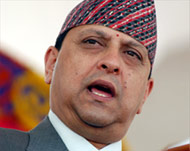Nepalese king unveils new cabinet
Nepal’s King Gyanendra has sworn in a new 10-member cabinet heavily dominated by royalists, a day after firing the government and seizing power in a move that has sparked international condemnation.

Members of the new cabinet arrived at the royal palace on Wednesday in black official cars for the brief oath-of-office ceremony that followed Gyanendra’s dismissal of prime minister Shah Bahadur Deuba and his government on Tuesday.
The king said the sacking of the ruling coalition was necessary to crush a Maoist revolt.
The new cabinet was mainly made up of pro-monarchists, including Foreign Minister Ramesh Nath Pandey, Finance Minister Madhukar Shumsher Rana and Dan Bahadur Shahi as home minister.
Security was tight on the streets of Kathmandu which were jammed as usual with traffic, while shops and businesses and schools were open. The international airport was also operational.
But land and mobile phone networks and internet links were still not working after being shut down on Tuesday.
Law and order plege
Gyanendra, vaulted to the throne four years ago by a palace massacre that wiped out most of the royal family, said he fired the multi-party government for failing to hold elections and bring peace to the country.
He pledged to “restore democracy and law and order in the country in the next three years”.
Security forces in the scenic mountain kingdom known as the Land of Everest have been battling for nine years to stamp out the revolt by Maoists seeking to topple the monarchy and install a communist republic.
|
“He [Gyanendra] wants to bring about peace and security … a good thing. But I doubt he’ll be successful and it’s a violation of the constitution” |
The conflict has claimed more than 11,000 lives.
Opposition leaders were out of sight and believed to be under house arrest.
Witnesses said security men dragged away GP Koirala, leader of the Nepali Congress, and Madhav Kumar Nepal, head of the Nepal Communist Party-United Marxist and Leninist Party, on Tuesday when they emerged from their homes to try to speak to reporters.
Lawyer Mitilesh Kumar Singh called the king’s move a “political tsunami. He wants to bring about peace and security … a good thing but I doubt he’ll be successful and it’s a violation of the constitution”.
Dismissal condemned
The king’s dismissal of the ruling coalition was condemned by the US, the United Nations, Britain and India as a setback for democracy.
India, along with the US and Britain, has been an important backer of Nepal in its drive to crush the insurgency.
New Delhi has a vital stake in helping quell the revolt as it fears Maoist violence could spill into parts of India where leftist groups are powerful.
 |
|
Gyanendra took the throne in |
In a sharply worded statement, New Delhi voiced “grave concern”, calling the king’s move “a serious setback to the cause of democracy in Nepal“.
The US was “deeply troubled by the apparent step back from democracy in Nepal“, Department of State spokesman Richard Boucher said.
The human-rights group Amnesty International also expressed concern, noting the last state of emergency in 2001-2002 led to an explosion of abuses, including killings, disappearances and detentions.
Gyanendra took the throne in 2001 after his brother King Birendra and most of the royal family were shot dead by the former crown prince, who was reportedly high on alcohol and drugs. The prince also killed himself, according to official accounts.